Design of E-Learning Application: English Teaching for Arabic Students
VerifiedAdded on 2020/04/13
|103
|23109
|48
Project
AI Summary
This project report details the design and implementation of a mobile e-learning application aimed at easing the difficulties of teaching English to Arabic students below the 4th-grade level. The application leverages Android technology and incorporates a word game to enhance vocabulary acquisition. The research includes a literature review of relevant educational technologies and methodologies, such as Agile software development. The project's objectives include designing an engaging mobile application, improving vocabulary skills, and enhancing the overall English teaching process. The methodology involves a research plan with project phases, methods, and data collection techniques. The results section analyzes user evaluations and the impact of the application on learning. The report also includes a critical appraisal of the application's features, learning theories, and recommendations for future development, including smart learning techniques.
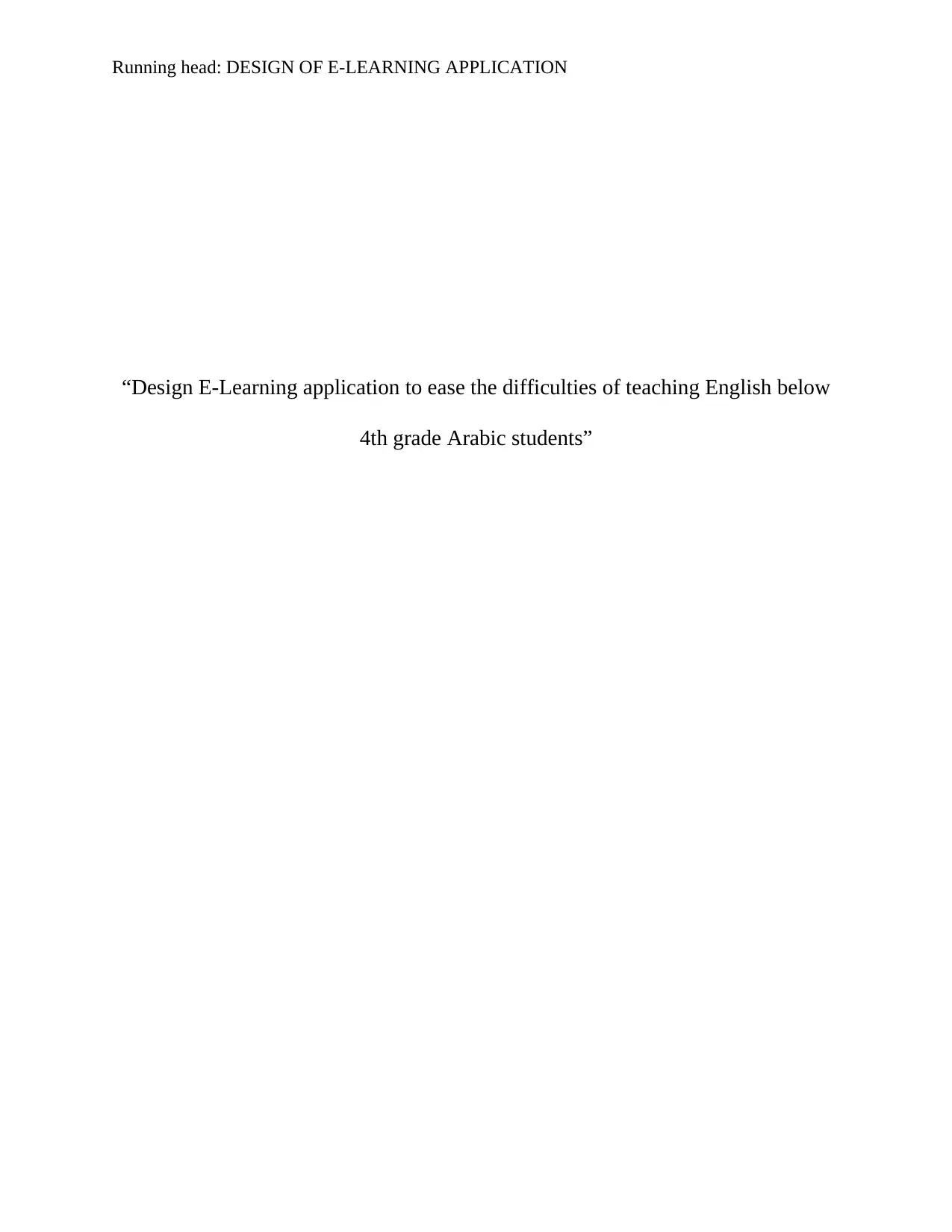
Running head: DESIGN OF E-LEARNING APPLICATION
“Design E-Learning application to ease the difficulties of teaching English below
4th grade Arabic students”
“Design E-Learning application to ease the difficulties of teaching English below
4th grade Arabic students”
Paraphrase This Document
Need a fresh take? Get an instant paraphrase of this document with our AI Paraphraser
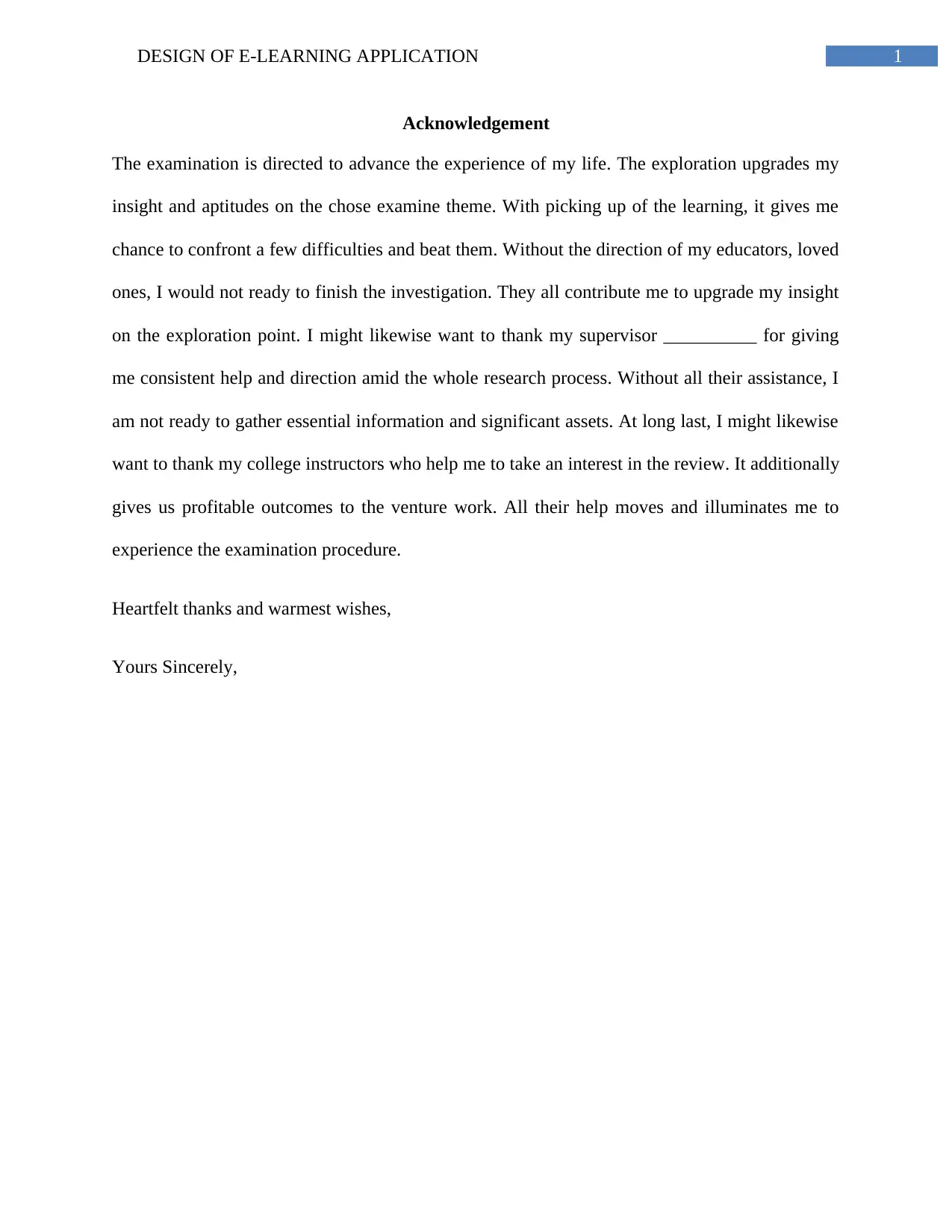
1DESIGN OF E-LEARNING APPLICATION
Acknowledgement
The examination is directed to advance the experience of my life. The exploration upgrades my
insight and aptitudes on the chose examine theme. With picking up of the learning, it gives me
chance to confront a few difficulties and beat them. Without the direction of my educators, loved
ones, I would not ready to finish the investigation. They all contribute me to upgrade my insight
on the exploration point. I might likewise want to thank my supervisor __________ for giving
me consistent help and direction amid the whole research process. Without all their assistance, I
am not ready to gather essential information and significant assets. At long last, I might likewise
want to thank my college instructors who help me to take an interest in the review. It additionally
gives us profitable outcomes to the venture work. All their help moves and illuminates me to
experience the examination procedure.
Heartfelt thanks and warmest wishes,
Yours Sincerely,
Acknowledgement
The examination is directed to advance the experience of my life. The exploration upgrades my
insight and aptitudes on the chose examine theme. With picking up of the learning, it gives me
chance to confront a few difficulties and beat them. Without the direction of my educators, loved
ones, I would not ready to finish the investigation. They all contribute me to upgrade my insight
on the exploration point. I might likewise want to thank my supervisor __________ for giving
me consistent help and direction amid the whole research process. Without all their assistance, I
am not ready to gather essential information and significant assets. At long last, I might likewise
want to thank my college instructors who help me to take an interest in the review. It additionally
gives us profitable outcomes to the venture work. All their help moves and illuminates me to
experience the examination procedure.
Heartfelt thanks and warmest wishes,
Yours Sincerely,
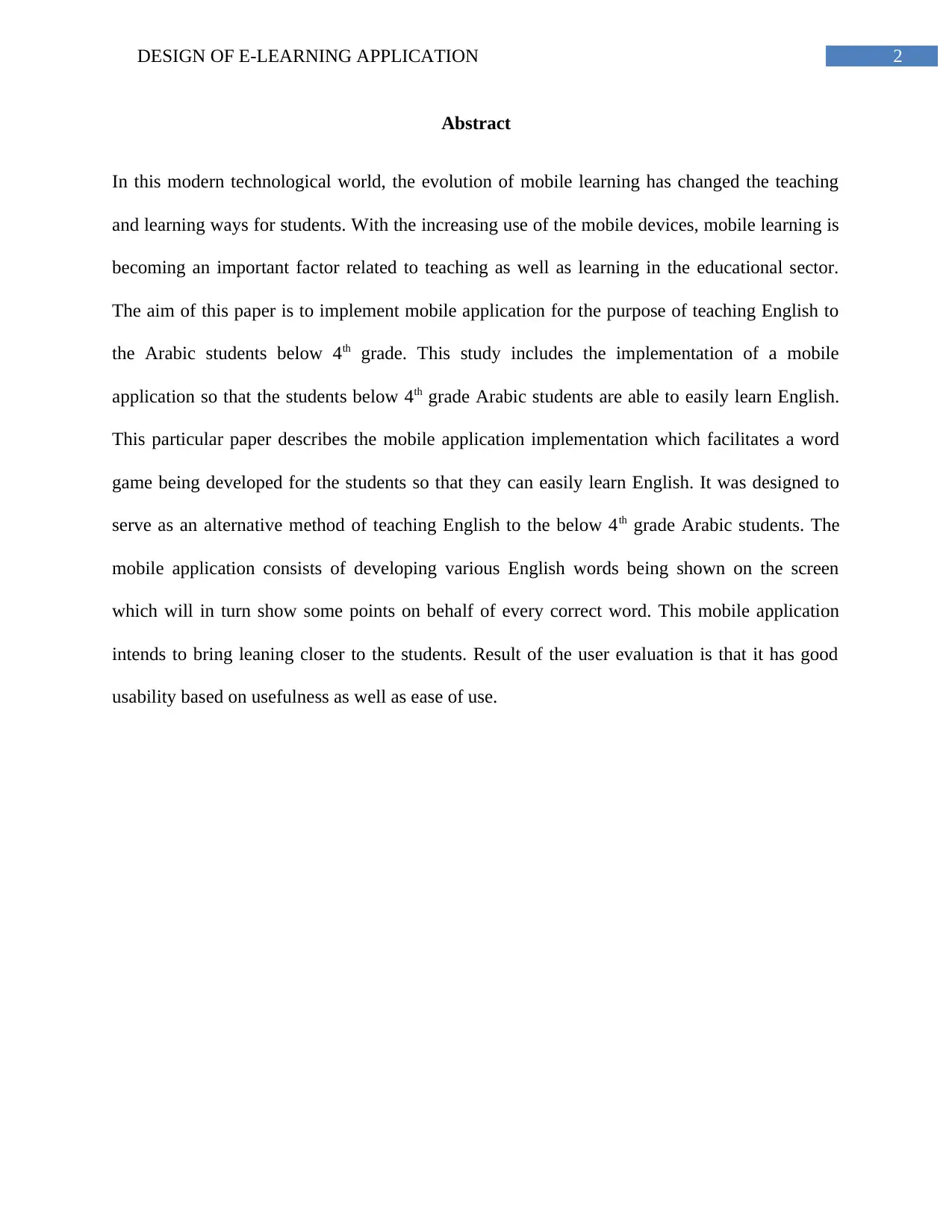
2DESIGN OF E-LEARNING APPLICATION
Abstract
In this modern technological world, the evolution of mobile learning has changed the teaching
and learning ways for students. With the increasing use of the mobile devices, mobile learning is
becoming an important factor related to teaching as well as learning in the educational sector.
The aim of this paper is to implement mobile application for the purpose of teaching English to
the Arabic students below 4th grade. This study includes the implementation of a mobile
application so that the students below 4th grade Arabic students are able to easily learn English.
This particular paper describes the mobile application implementation which facilitates a word
game being developed for the students so that they can easily learn English. It was designed to
serve as an alternative method of teaching English to the below 4th grade Arabic students. The
mobile application consists of developing various English words being shown on the screen
which will in turn show some points on behalf of every correct word. This mobile application
intends to bring leaning closer to the students. Result of the user evaluation is that it has good
usability based on usefulness as well as ease of use.
Abstract
In this modern technological world, the evolution of mobile learning has changed the teaching
and learning ways for students. With the increasing use of the mobile devices, mobile learning is
becoming an important factor related to teaching as well as learning in the educational sector.
The aim of this paper is to implement mobile application for the purpose of teaching English to
the Arabic students below 4th grade. This study includes the implementation of a mobile
application so that the students below 4th grade Arabic students are able to easily learn English.
This particular paper describes the mobile application implementation which facilitates a word
game being developed for the students so that they can easily learn English. It was designed to
serve as an alternative method of teaching English to the below 4th grade Arabic students. The
mobile application consists of developing various English words being shown on the screen
which will in turn show some points on behalf of every correct word. This mobile application
intends to bring leaning closer to the students. Result of the user evaluation is that it has good
usability based on usefulness as well as ease of use.
⊘ This is a preview!⊘
Do you want full access?
Subscribe today to unlock all pages.

Trusted by 1+ million students worldwide
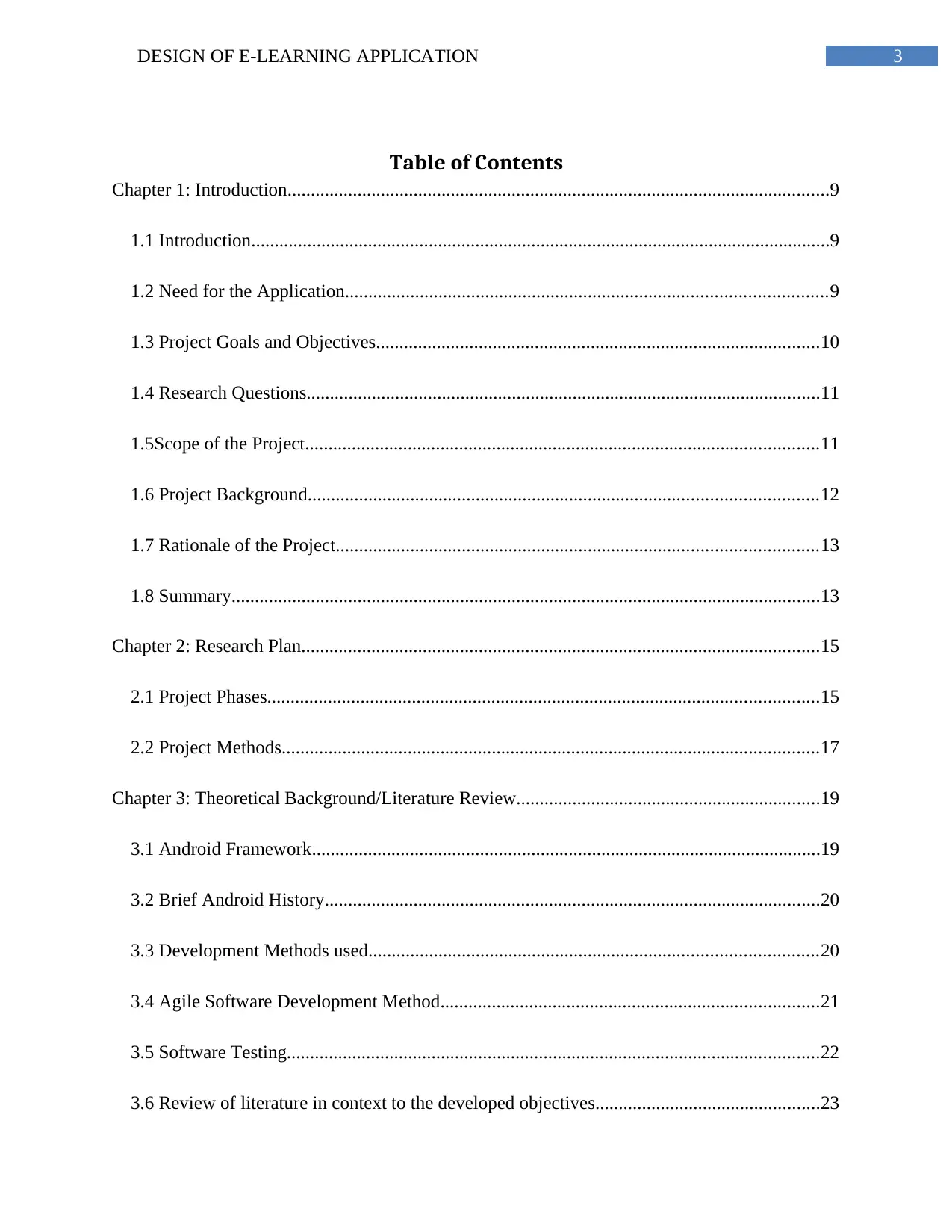
3DESIGN OF E-LEARNING APPLICATION
Table of Contents
Chapter 1: Introduction....................................................................................................................9
1.1 Introduction............................................................................................................................9
1.2 Need for the Application.......................................................................................................9
1.3 Project Goals and Objectives...............................................................................................10
1.4 Research Questions..............................................................................................................11
1.5Scope of the Project..............................................................................................................11
1.6 Project Background.............................................................................................................12
1.7 Rationale of the Project.......................................................................................................13
1.8 Summary..............................................................................................................................13
Chapter 2: Research Plan...............................................................................................................15
2.1 Project Phases......................................................................................................................15
2.2 Project Methods...................................................................................................................17
Chapter 3: Theoretical Background/Literature Review.................................................................19
3.1 Android Framework.............................................................................................................19
3.2 Brief Android History..........................................................................................................20
3.3 Development Methods used................................................................................................20
3.4 Agile Software Development Method.................................................................................21
3.5 Software Testing..................................................................................................................22
3.6 Review of literature in context to the developed objectives................................................23
Table of Contents
Chapter 1: Introduction....................................................................................................................9
1.1 Introduction............................................................................................................................9
1.2 Need for the Application.......................................................................................................9
1.3 Project Goals and Objectives...............................................................................................10
1.4 Research Questions..............................................................................................................11
1.5Scope of the Project..............................................................................................................11
1.6 Project Background.............................................................................................................12
1.7 Rationale of the Project.......................................................................................................13
1.8 Summary..............................................................................................................................13
Chapter 2: Research Plan...............................................................................................................15
2.1 Project Phases......................................................................................................................15
2.2 Project Methods...................................................................................................................17
Chapter 3: Theoretical Background/Literature Review.................................................................19
3.1 Android Framework.............................................................................................................19
3.2 Brief Android History..........................................................................................................20
3.3 Development Methods used................................................................................................20
3.4 Agile Software Development Method.................................................................................21
3.5 Software Testing..................................................................................................................22
3.6 Review of literature in context to the developed objectives................................................23
Paraphrase This Document
Need a fresh take? Get an instant paraphrase of this document with our AI Paraphraser
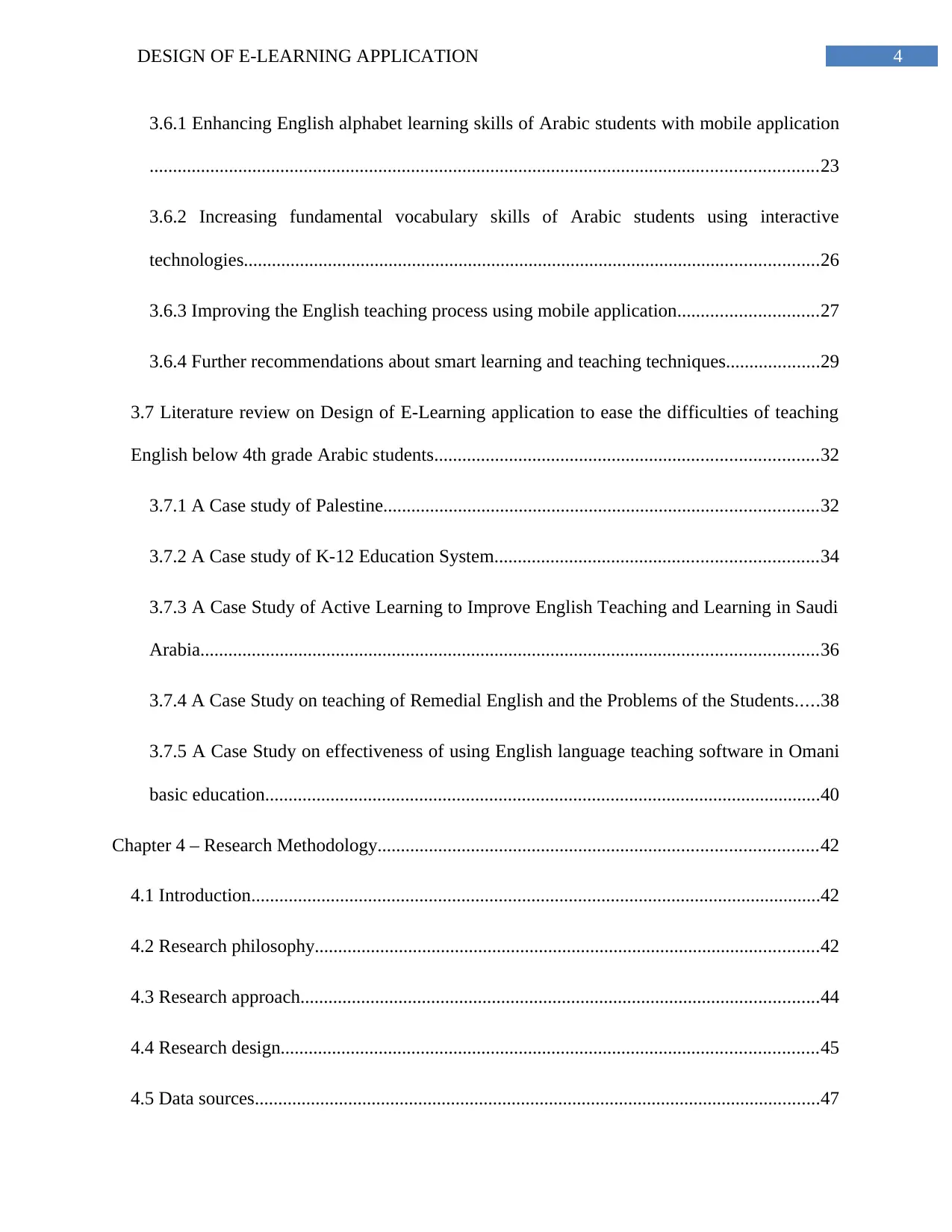
4DESIGN OF E-LEARNING APPLICATION
3.6.1 Enhancing English alphabet learning skills of Arabic students with mobile application
...............................................................................................................................................23
3.6.2 Increasing fundamental vocabulary skills of Arabic students using interactive
technologies...........................................................................................................................26
3.6.3 Improving the English teaching process using mobile application..............................27
3.6.4 Further recommendations about smart learning and teaching techniques....................29
3.7 Literature review on Design of E-Learning application to ease the difficulties of teaching
English below 4th grade Arabic students..................................................................................32
3.7.1 A Case study of Palestine.............................................................................................32
3.7.2 A Case study of K-12 Education System.....................................................................34
3.7.3 A Case Study of Active Learning to Improve English Teaching and Learning in Saudi
Arabia....................................................................................................................................36
3.7.4 A Case Study on teaching of Remedial English and the Problems of the Students.....38
3.7.5 A Case Study on effectiveness of using English language teaching software in Omani
basic education.......................................................................................................................40
Chapter 4 – Research Methodology..............................................................................................42
4.1 Introduction..........................................................................................................................42
4.2 Research philosophy............................................................................................................42
4.3 Research approach...............................................................................................................44
4.4 Research design...................................................................................................................45
4.5 Data sources.........................................................................................................................47
3.6.1 Enhancing English alphabet learning skills of Arabic students with mobile application
...............................................................................................................................................23
3.6.2 Increasing fundamental vocabulary skills of Arabic students using interactive
technologies...........................................................................................................................26
3.6.3 Improving the English teaching process using mobile application..............................27
3.6.4 Further recommendations about smart learning and teaching techniques....................29
3.7 Literature review on Design of E-Learning application to ease the difficulties of teaching
English below 4th grade Arabic students..................................................................................32
3.7.1 A Case study of Palestine.............................................................................................32
3.7.2 A Case study of K-12 Education System.....................................................................34
3.7.3 A Case Study of Active Learning to Improve English Teaching and Learning in Saudi
Arabia....................................................................................................................................36
3.7.4 A Case Study on teaching of Remedial English and the Problems of the Students.....38
3.7.5 A Case Study on effectiveness of using English language teaching software in Omani
basic education.......................................................................................................................40
Chapter 4 – Research Methodology..............................................................................................42
4.1 Introduction..........................................................................................................................42
4.2 Research philosophy............................................................................................................42
4.3 Research approach...............................................................................................................44
4.4 Research design...................................................................................................................45
4.5 Data sources.........................................................................................................................47
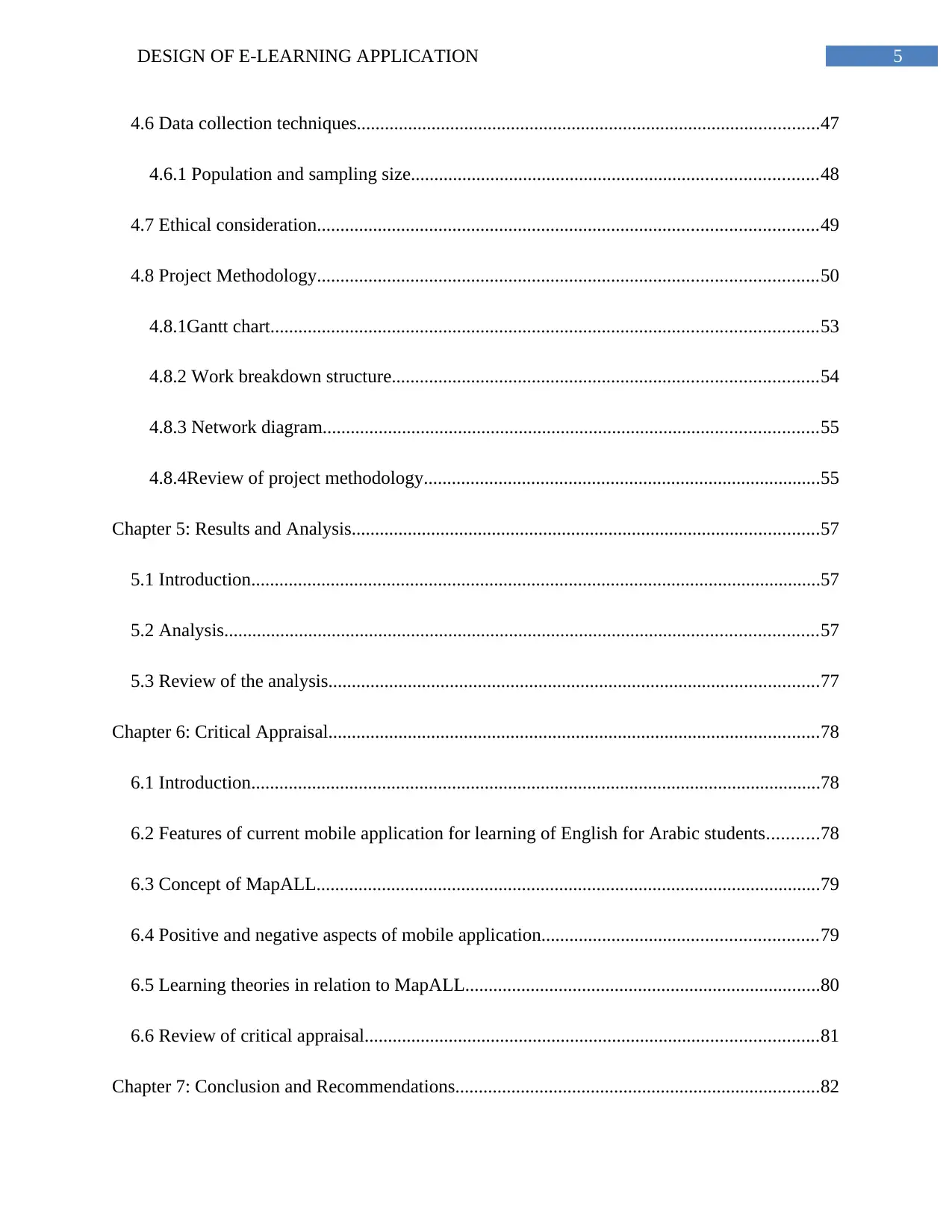
5DESIGN OF E-LEARNING APPLICATION
4.6 Data collection techniques...................................................................................................47
4.6.1 Population and sampling size.......................................................................................48
4.7 Ethical consideration...........................................................................................................49
4.8 Project Methodology...........................................................................................................50
4.8.1Gantt chart.....................................................................................................................53
4.8.2 Work breakdown structure...........................................................................................54
4.8.3 Network diagram..........................................................................................................55
4.8.4Review of project methodology.....................................................................................55
Chapter 5: Results and Analysis....................................................................................................57
5.1 Introduction..........................................................................................................................57
5.2 Analysis...............................................................................................................................57
5.3 Review of the analysis.........................................................................................................77
Chapter 6: Critical Appraisal.........................................................................................................78
6.1 Introduction..........................................................................................................................78
6.2 Features of current mobile application for learning of English for Arabic students...........78
6.3 Concept of MapALL............................................................................................................79
6.4 Positive and negative aspects of mobile application...........................................................79
6.5 Learning theories in relation to MapALL............................................................................80
6.6 Review of critical appraisal.................................................................................................81
Chapter 7: Conclusion and Recommendations..............................................................................82
4.6 Data collection techniques...................................................................................................47
4.6.1 Population and sampling size.......................................................................................48
4.7 Ethical consideration...........................................................................................................49
4.8 Project Methodology...........................................................................................................50
4.8.1Gantt chart.....................................................................................................................53
4.8.2 Work breakdown structure...........................................................................................54
4.8.3 Network diagram..........................................................................................................55
4.8.4Review of project methodology.....................................................................................55
Chapter 5: Results and Analysis....................................................................................................57
5.1 Introduction..........................................................................................................................57
5.2 Analysis...............................................................................................................................57
5.3 Review of the analysis.........................................................................................................77
Chapter 6: Critical Appraisal.........................................................................................................78
6.1 Introduction..........................................................................................................................78
6.2 Features of current mobile application for learning of English for Arabic students...........78
6.3 Concept of MapALL............................................................................................................79
6.4 Positive and negative aspects of mobile application...........................................................79
6.5 Learning theories in relation to MapALL............................................................................80
6.6 Review of critical appraisal.................................................................................................81
Chapter 7: Conclusion and Recommendations..............................................................................82
⊘ This is a preview!⊘
Do you want full access?
Subscribe today to unlock all pages.

Trusted by 1+ million students worldwide
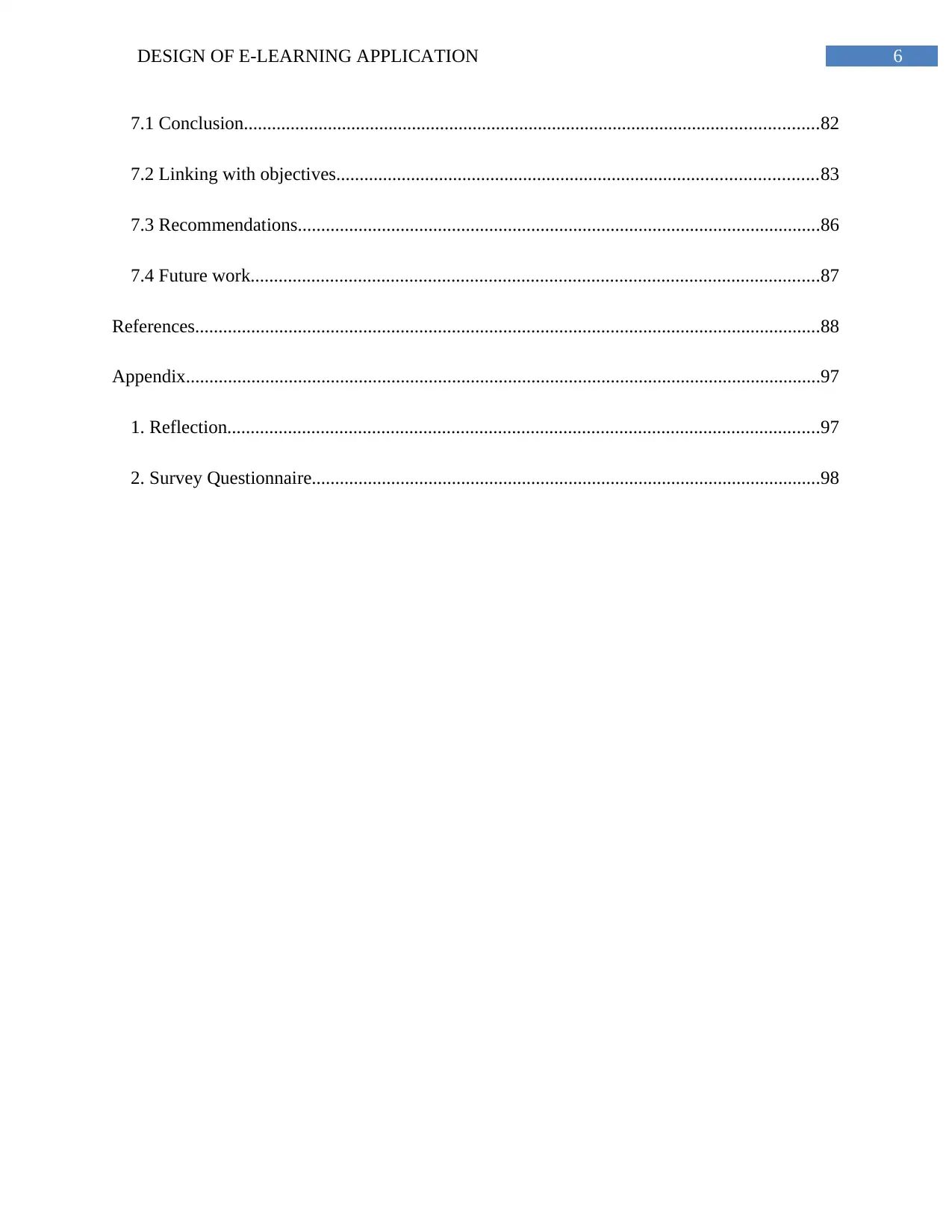
6DESIGN OF E-LEARNING APPLICATION
7.1 Conclusion...........................................................................................................................82
7.2 Linking with objectives.......................................................................................................83
7.3 Recommendations................................................................................................................86
7.4 Future work..........................................................................................................................87
References......................................................................................................................................88
Appendix........................................................................................................................................97
1. Reflection...............................................................................................................................97
2. Survey Questionnaire.............................................................................................................98
7.1 Conclusion...........................................................................................................................82
7.2 Linking with objectives.......................................................................................................83
7.3 Recommendations................................................................................................................86
7.4 Future work..........................................................................................................................87
References......................................................................................................................................88
Appendix........................................................................................................................................97
1. Reflection...............................................................................................................................97
2. Survey Questionnaire.............................................................................................................98
Paraphrase This Document
Need a fresh take? Get an instant paraphrase of this document with our AI Paraphraser
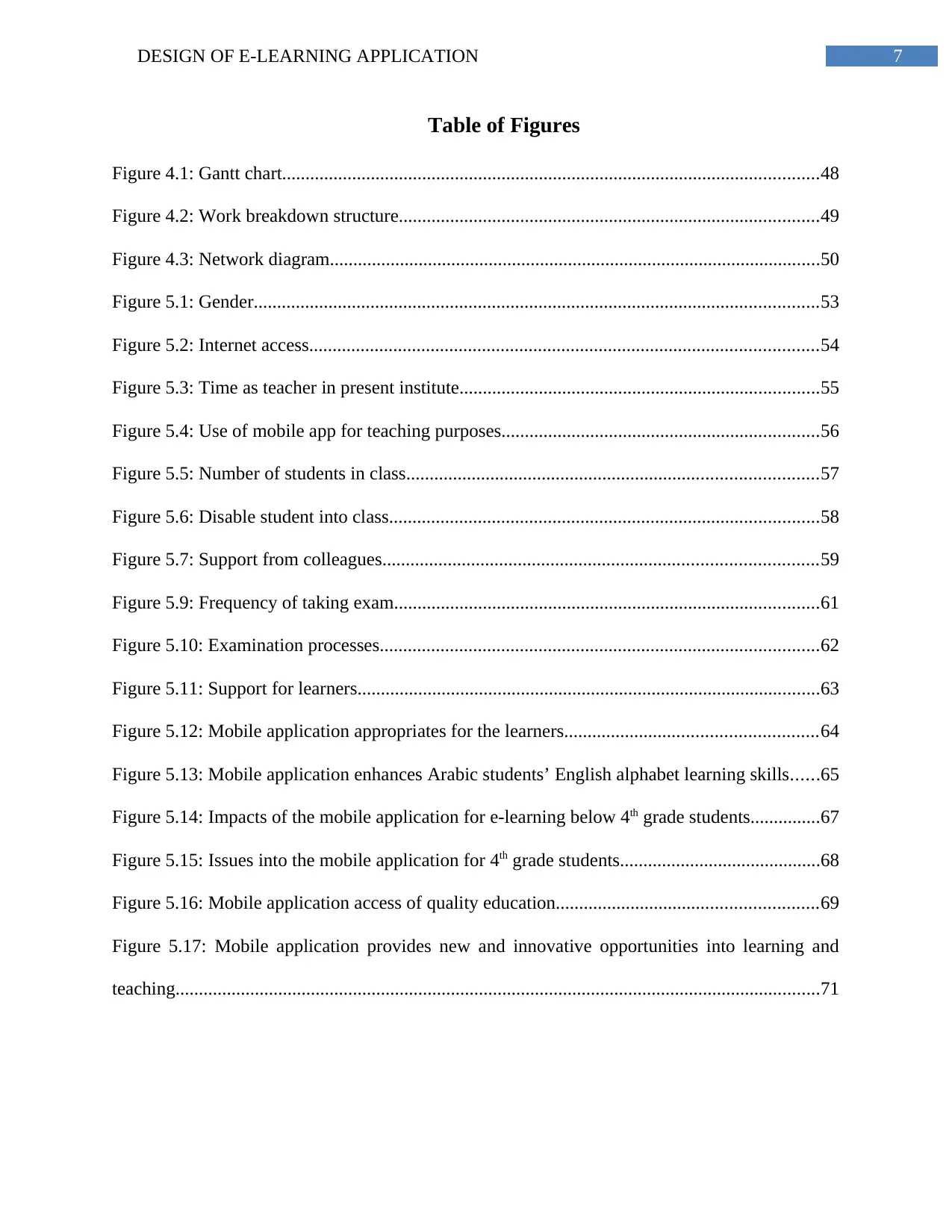
7DESIGN OF E-LEARNING APPLICATION
Table of Figures
Figure 4.1: Gantt chart...................................................................................................................48
Figure 4.2: Work breakdown structure..........................................................................................49
Figure 4.3: Network diagram.........................................................................................................50
Figure 5.1: Gender.........................................................................................................................53
Figure 5.2: Internet access.............................................................................................................54
Figure 5.3: Time as teacher in present institute.............................................................................55
Figure 5.4: Use of mobile app for teaching purposes....................................................................56
Figure 5.5: Number of students in class........................................................................................57
Figure 5.6: Disable student into class............................................................................................58
Figure 5.7: Support from colleagues.............................................................................................59
Figure 5.9: Frequency of taking exam...........................................................................................61
Figure 5.10: Examination processes..............................................................................................62
Figure 5.11: Support for learners...................................................................................................63
Figure 5.12: Mobile application appropriates for the learners......................................................64
Figure 5.13: Mobile application enhances Arabic students’ English alphabet learning skills......65
Figure 5.14: Impacts of the mobile application for e-learning below 4th grade students...............67
Figure 5.15: Issues into the mobile application for 4th grade students...........................................68
Figure 5.16: Mobile application access of quality education........................................................69
Figure 5.17: Mobile application provides new and innovative opportunities into learning and
teaching..........................................................................................................................................71
Table of Figures
Figure 4.1: Gantt chart...................................................................................................................48
Figure 4.2: Work breakdown structure..........................................................................................49
Figure 4.3: Network diagram.........................................................................................................50
Figure 5.1: Gender.........................................................................................................................53
Figure 5.2: Internet access.............................................................................................................54
Figure 5.3: Time as teacher in present institute.............................................................................55
Figure 5.4: Use of mobile app for teaching purposes....................................................................56
Figure 5.5: Number of students in class........................................................................................57
Figure 5.6: Disable student into class............................................................................................58
Figure 5.7: Support from colleagues.............................................................................................59
Figure 5.9: Frequency of taking exam...........................................................................................61
Figure 5.10: Examination processes..............................................................................................62
Figure 5.11: Support for learners...................................................................................................63
Figure 5.12: Mobile application appropriates for the learners......................................................64
Figure 5.13: Mobile application enhances Arabic students’ English alphabet learning skills......65
Figure 5.14: Impacts of the mobile application for e-learning below 4th grade students...............67
Figure 5.15: Issues into the mobile application for 4th grade students...........................................68
Figure 5.16: Mobile application access of quality education........................................................69
Figure 5.17: Mobile application provides new and innovative opportunities into learning and
teaching..........................................................................................................................................71
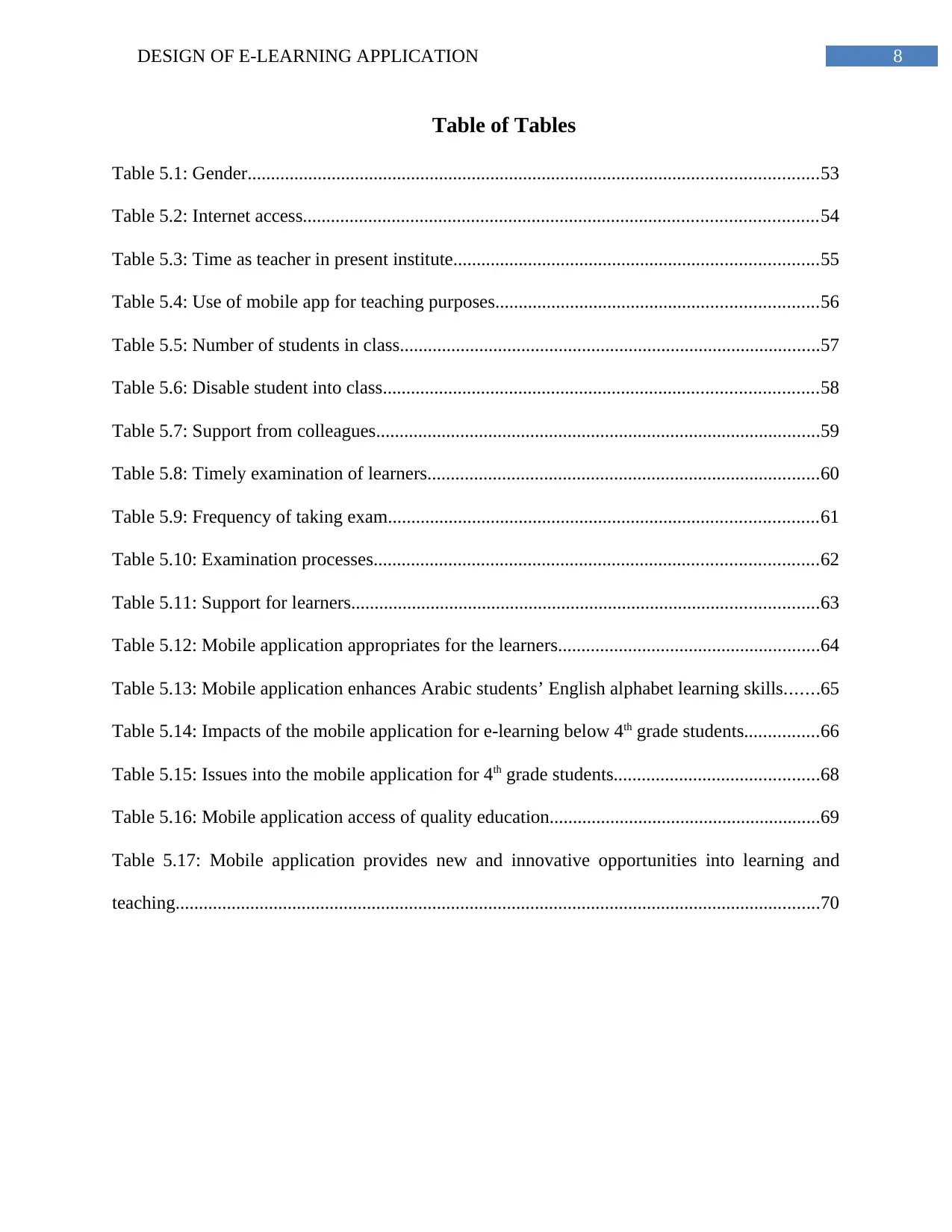
8DESIGN OF E-LEARNING APPLICATION
Table of Tables
Table 5.1: Gender..........................................................................................................................53
Table 5.2: Internet access..............................................................................................................54
Table 5.3: Time as teacher in present institute..............................................................................55
Table 5.4: Use of mobile app for teaching purposes.....................................................................56
Table 5.5: Number of students in class..........................................................................................57
Table 5.6: Disable student into class.............................................................................................58
Table 5.7: Support from colleagues...............................................................................................59
Table 5.8: Timely examination of learners....................................................................................60
Table 5.9: Frequency of taking exam............................................................................................61
Table 5.10: Examination processes...............................................................................................62
Table 5.11: Support for learners....................................................................................................63
Table 5.12: Mobile application appropriates for the learners........................................................64
Table 5.13: Mobile application enhances Arabic students’ English alphabet learning skills.......65
Table 5.14: Impacts of the mobile application for e-learning below 4th grade students................66
Table 5.15: Issues into the mobile application for 4th grade students............................................68
Table 5.16: Mobile application access of quality education..........................................................69
Table 5.17: Mobile application provides new and innovative opportunities into learning and
teaching..........................................................................................................................................70
Table of Tables
Table 5.1: Gender..........................................................................................................................53
Table 5.2: Internet access..............................................................................................................54
Table 5.3: Time as teacher in present institute..............................................................................55
Table 5.4: Use of mobile app for teaching purposes.....................................................................56
Table 5.5: Number of students in class..........................................................................................57
Table 5.6: Disable student into class.............................................................................................58
Table 5.7: Support from colleagues...............................................................................................59
Table 5.8: Timely examination of learners....................................................................................60
Table 5.9: Frequency of taking exam............................................................................................61
Table 5.10: Examination processes...............................................................................................62
Table 5.11: Support for learners....................................................................................................63
Table 5.12: Mobile application appropriates for the learners........................................................64
Table 5.13: Mobile application enhances Arabic students’ English alphabet learning skills.......65
Table 5.14: Impacts of the mobile application for e-learning below 4th grade students................66
Table 5.15: Issues into the mobile application for 4th grade students............................................68
Table 5.16: Mobile application access of quality education..........................................................69
Table 5.17: Mobile application provides new and innovative opportunities into learning and
teaching..........................................................................................................................................70
⊘ This is a preview!⊘
Do you want full access?
Subscribe today to unlock all pages.

Trusted by 1+ million students worldwide
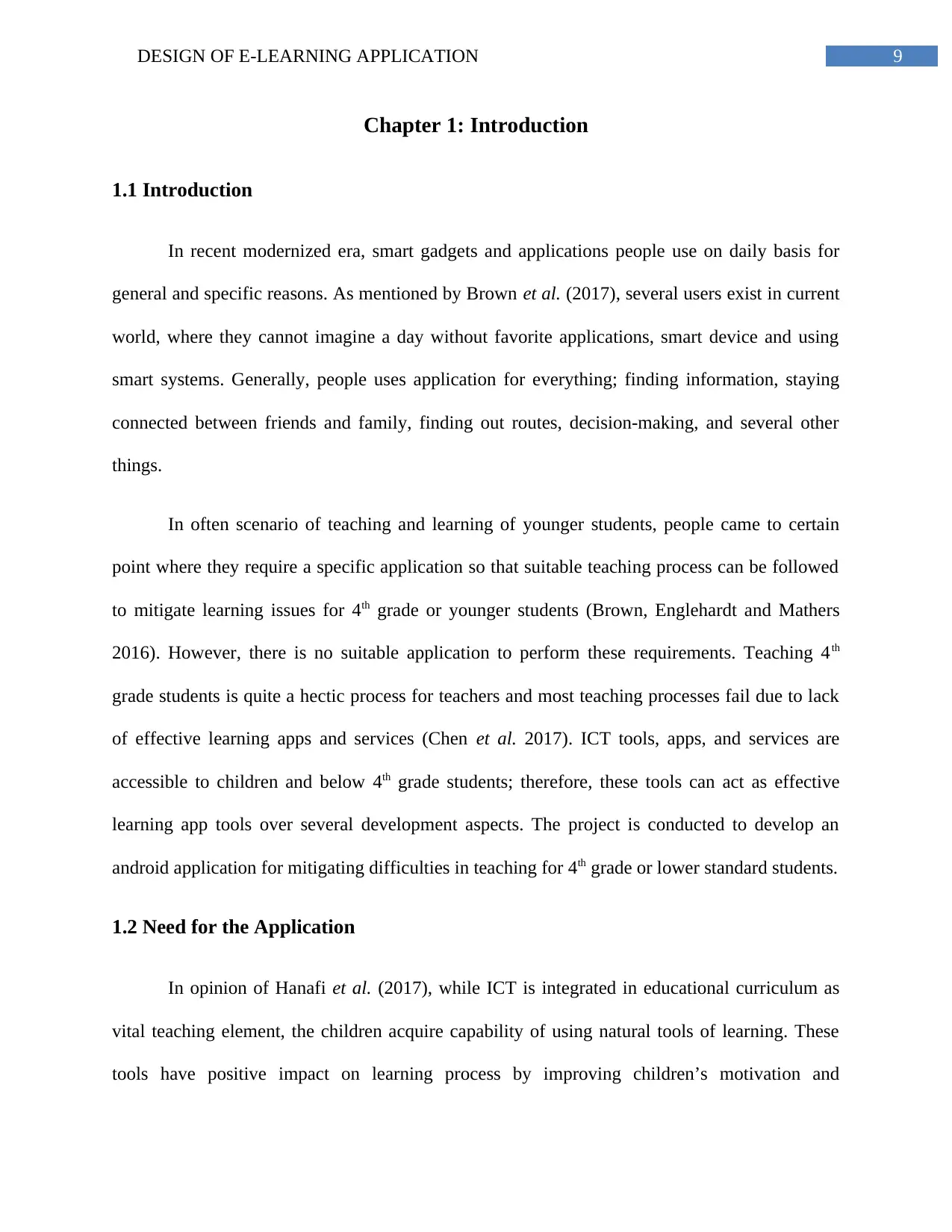
9DESIGN OF E-LEARNING APPLICATION
Chapter 1: Introduction
1.1 Introduction
In recent modernized era, smart gadgets and applications people use on daily basis for
general and specific reasons. As mentioned by Brown et al. (2017), several users exist in current
world, where they cannot imagine a day without favorite applications, smart device and using
smart systems. Generally, people uses application for everything; finding information, staying
connected between friends and family, finding out routes, decision-making, and several other
things.
In often scenario of teaching and learning of younger students, people came to certain
point where they require a specific application so that suitable teaching process can be followed
to mitigate learning issues for 4th grade or younger students (Brown, Englehardt and Mathers
2016). However, there is no suitable application to perform these requirements. Teaching 4th
grade students is quite a hectic process for teachers and most teaching processes fail due to lack
of effective learning apps and services (Chen et al. 2017). ICT tools, apps, and services are
accessible to children and below 4th grade students; therefore, these tools can act as effective
learning app tools over several development aspects. The project is conducted to develop an
android application for mitigating difficulties in teaching for 4th grade or lower standard students.
1.2 Need for the Application
In opinion of Hanafi et al. (2017), while ICT is integrated in educational curriculum as
vital teaching element, the children acquire capability of using natural tools of learning. These
tools have positive impact on learning process by improving children’s motivation and
Chapter 1: Introduction
1.1 Introduction
In recent modernized era, smart gadgets and applications people use on daily basis for
general and specific reasons. As mentioned by Brown et al. (2017), several users exist in current
world, where they cannot imagine a day without favorite applications, smart device and using
smart systems. Generally, people uses application for everything; finding information, staying
connected between friends and family, finding out routes, decision-making, and several other
things.
In often scenario of teaching and learning of younger students, people came to certain
point where they require a specific application so that suitable teaching process can be followed
to mitigate learning issues for 4th grade or younger students (Brown, Englehardt and Mathers
2016). However, there is no suitable application to perform these requirements. Teaching 4th
grade students is quite a hectic process for teachers and most teaching processes fail due to lack
of effective learning apps and services (Chen et al. 2017). ICT tools, apps, and services are
accessible to children and below 4th grade students; therefore, these tools can act as effective
learning app tools over several development aspects. The project is conducted to develop an
android application for mitigating difficulties in teaching for 4th grade or lower standard students.
1.2 Need for the Application
In opinion of Hanafi et al. (2017), while ICT is integrated in educational curriculum as
vital teaching element, the children acquire capability of using natural tools of learning. These
tools have positive impact on learning process by improving children’s motivation and
Paraphrase This Document
Need a fresh take? Get an instant paraphrase of this document with our AI Paraphraser
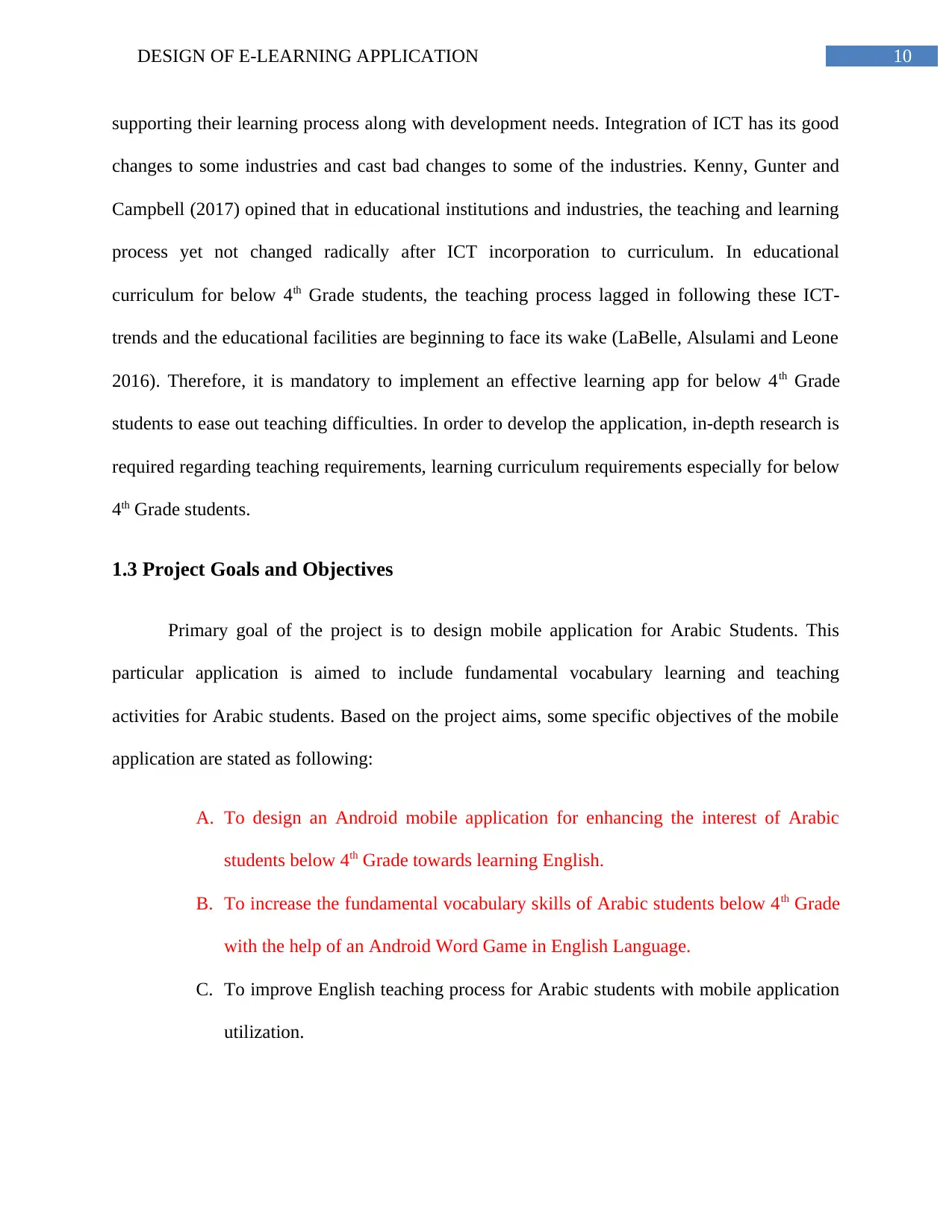
10DESIGN OF E-LEARNING APPLICATION
supporting their learning process along with development needs. Integration of ICT has its good
changes to some industries and cast bad changes to some of the industries. Kenny, Gunter and
Campbell (2017) opined that in educational institutions and industries, the teaching and learning
process yet not changed radically after ICT incorporation to curriculum. In educational
curriculum for below 4th Grade students, the teaching process lagged in following these ICT-
trends and the educational facilities are beginning to face its wake (LaBelle, Alsulami and Leone
2016). Therefore, it is mandatory to implement an effective learning app for below 4th Grade
students to ease out teaching difficulties. In order to develop the application, in-depth research is
required regarding teaching requirements, learning curriculum requirements especially for below
4th Grade students.
1.3 Project Goals and Objectives
Primary goal of the project is to design mobile application for Arabic Students. This
particular application is aimed to include fundamental vocabulary learning and teaching
activities for Arabic students. Based on the project aims, some specific objectives of the mobile
application are stated as following:
A. To design an Android mobile application for enhancing the interest of Arabic
students below 4th Grade towards learning English.
B. To increase the fundamental vocabulary skills of Arabic students below 4th Grade
with the help of an Android Word Game in English Language.
C. To improve English teaching process for Arabic students with mobile application
utilization.
supporting their learning process along with development needs. Integration of ICT has its good
changes to some industries and cast bad changes to some of the industries. Kenny, Gunter and
Campbell (2017) opined that in educational institutions and industries, the teaching and learning
process yet not changed radically after ICT incorporation to curriculum. In educational
curriculum for below 4th Grade students, the teaching process lagged in following these ICT-
trends and the educational facilities are beginning to face its wake (LaBelle, Alsulami and Leone
2016). Therefore, it is mandatory to implement an effective learning app for below 4th Grade
students to ease out teaching difficulties. In order to develop the application, in-depth research is
required regarding teaching requirements, learning curriculum requirements especially for below
4th Grade students.
1.3 Project Goals and Objectives
Primary goal of the project is to design mobile application for Arabic Students. This
particular application is aimed to include fundamental vocabulary learning and teaching
activities for Arabic students. Based on the project aims, some specific objectives of the mobile
application are stated as following:
A. To design an Android mobile application for enhancing the interest of Arabic
students below 4th Grade towards learning English.
B. To increase the fundamental vocabulary skills of Arabic students below 4th Grade
with the help of an Android Word Game in English Language.
C. To improve English teaching process for Arabic students with mobile application
utilization.
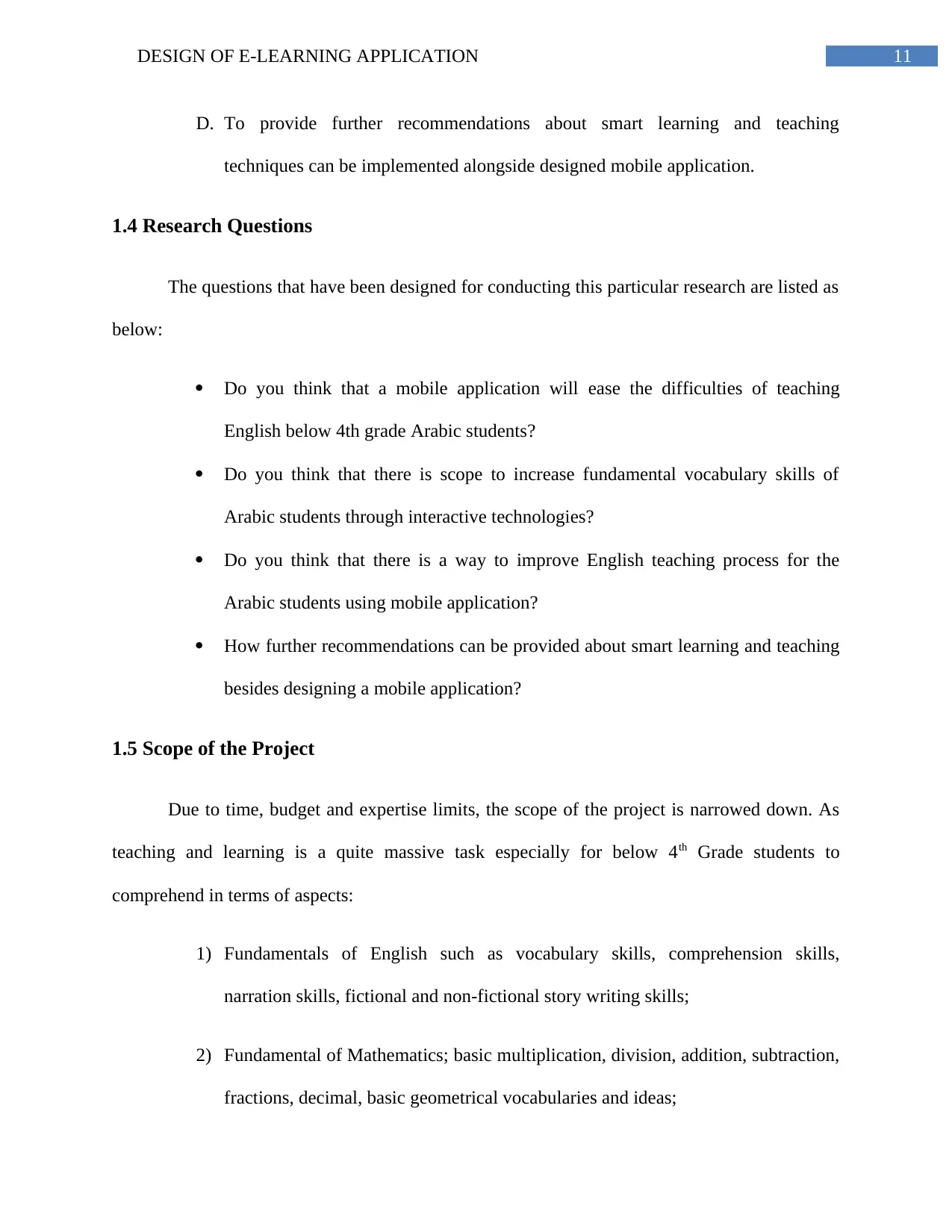
11DESIGN OF E-LEARNING APPLICATION
D. To provide further recommendations about smart learning and teaching
techniques can be implemented alongside designed mobile application.
1.4 Research Questions
The questions that have been designed for conducting this particular research are listed as
below:
Do you think that a mobile application will ease the difficulties of teaching
English below 4th grade Arabic students?
Do you think that there is scope to increase fundamental vocabulary skills of
Arabic students through interactive technologies?
Do you think that there is a way to improve English teaching process for the
Arabic students using mobile application?
How further recommendations can be provided about smart learning and teaching
besides designing a mobile application?
1.5 Scope of the Project
Due to time, budget and expertise limits, the scope of the project is narrowed down. As
teaching and learning is a quite massive task especially for below 4th Grade students to
comprehend in terms of aspects:
1) Fundamentals of English such as vocabulary skills, comprehension skills,
narration skills, fictional and non-fictional story writing skills;
2) Fundamental of Mathematics; basic multiplication, division, addition, subtraction,
fractions, decimal, basic geometrical vocabularies and ideas;
D. To provide further recommendations about smart learning and teaching
techniques can be implemented alongside designed mobile application.
1.4 Research Questions
The questions that have been designed for conducting this particular research are listed as
below:
Do you think that a mobile application will ease the difficulties of teaching
English below 4th grade Arabic students?
Do you think that there is scope to increase fundamental vocabulary skills of
Arabic students through interactive technologies?
Do you think that there is a way to improve English teaching process for the
Arabic students using mobile application?
How further recommendations can be provided about smart learning and teaching
besides designing a mobile application?
1.5 Scope of the Project
Due to time, budget and expertise limits, the scope of the project is narrowed down. As
teaching and learning is a quite massive task especially for below 4th Grade students to
comprehend in terms of aspects:
1) Fundamentals of English such as vocabulary skills, comprehension skills,
narration skills, fictional and non-fictional story writing skills;
2) Fundamental of Mathematics; basic multiplication, division, addition, subtraction,
fractions, decimal, basic geometrical vocabularies and ideas;
⊘ This is a preview!⊘
Do you want full access?
Subscribe today to unlock all pages.

Trusted by 1+ million students worldwide
1 out of 103
Related Documents
Your All-in-One AI-Powered Toolkit for Academic Success.
+13062052269
info@desklib.com
Available 24*7 on WhatsApp / Email
![[object Object]](/_next/static/media/star-bottom.7253800d.svg)
Unlock your academic potential
Copyright © 2020–2025 A2Z Services. All Rights Reserved. Developed and managed by ZUCOL.





